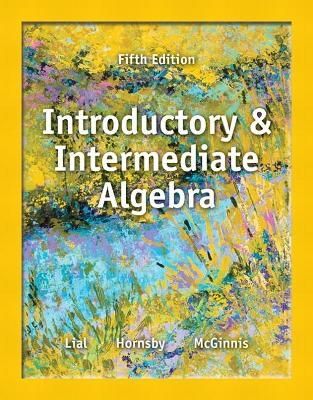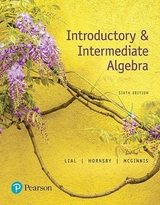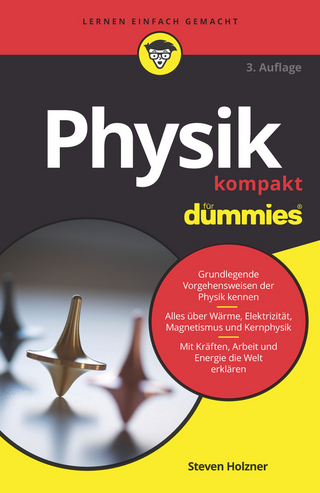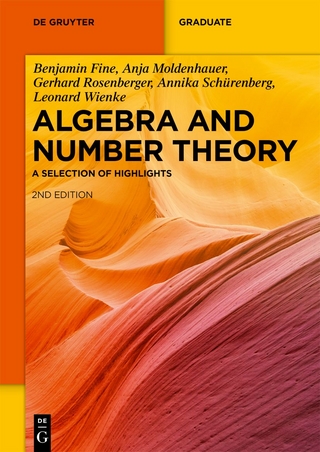
Introductory and Intermediate Algebra
Pearson (Verlag)
978-0-321-86553-3 (ISBN)
- Titel erscheint in neuer Auflage
- Artikel merken
NOTE: This is the standalone book, if you want the book/access card order the ISBN below:
0321900367 / 9780321900364 Introductory and Intermediate Algebra plus NEW MyMathLab with Pearson eText -- Access Card Package
Package consists of:
0321431308 / 9780321431301 MyMathLab -- Glue-in Access Card
0321654064 / 9780321654069 MyMathLab Inside Star Sticker
0321865537 / 9780321865533 Introductory and Intermediate Algebra
Marge Lial (late) became interested in math at an early age–it was her favorite subject in the first grade! Marge's intense desire to educate both her students and herself inspired the writing of numerous best-selling textbooks. Marge, who received Bachelor's and Master's degrees from California State University at Sacramento, was affiliated with American River College. An avid reader and traveler, her travel experiences often found their way into her books as applications, exercise sets, and feature sets. She was particularly interested in archeology; trips to various digs and ruin sites produced some fascinating problems for her textbooks involving such topics as the building of Mayan pyramids and the acoustics of ancient ball courts in the Yucatan. We dedicate the new editions of the paperback developmental math series to Marge in honor of her contributions to the field in which she helped thousands of students succeed. When John Hornsby enrolled as an undergraduate at Louisiana State University, he was uncertain whether he wanted to study mathematics education or journalism. His ultimate decision was to become a teacher, but after twenty-five years of teaching at the high school and university levels and fifteen years of writing mathematics textbooks, both of his goals have been realized. His love for both teaching and for mathematics is evident in his passion for working with students and fellow teachers as well. His specific professional interests are recreational mathematics, mathematics history, and incorporating graphing calculators into the curriculum. John's personal life is busy as he devotes time to his family (wife Gwen, and sons Chris, Jack, and Josh). He has been a rabid baseball fan all of his life. John's other hobbies include numismatics (the study of coins) and record collecting. He loves the music of the 1960s and has an extensive collection of the recorded works of Frankie Valli and the Four Seasons. A native Midwesterner, Terry McGinnis received her Bachelor’s of Science in Elementary Education with a concentration in Mathematics from Iowa State University. She has taught elementary and middle school mathematics, and developed and implemented the curriculum used with her students. Terry has been involved in college mathematics publishing for over 20 years, working with a variety of authors on textbooks in developmental mathematics and precalculus. After working behind the scenes on many of the Lial/Hornsby textbooks and supplements for over 10 years, Terry joined Margaret Lial and John Hornsby in 2002 as coauthor of their developmental mathematics series that includes Introductory Algebra, Intermediate Algebra, and Introductory and Intermediate Algebra. When not working, Terry enjoys spinning at a local health club, walking, and reading fiction. She is the devoted mother of two sons, Andrew and Tyler.
R. Prealgebra Review
R.1 Fractions
R.2 Decimals and Percents
Study Skills: Using Your Math Textbook
Study Skills: Reading Your Math Textbook
1. The Real Number System
1.1 Exponents, Order of Operations, and Inequality
Study Skills: Taking Lecture Notes
1.2 Variables, Expressions, and Equations
Study Skills: Tackling Your Homework
1.3 Real Numbers and the Number Line
Study Skills: Using Study Cards
1.4 Adding Real Numbers
1.5 Subtracting Real Numbers
1.6 Multiplying and Dividing Real Numbers
Summary Exercises Performing Operations with Real Numbers
1.7 Properties of Real Numbers
Study Skills: Reviewing a Chapter
1.8 Simplifying Expressions
Study Skills: Taking Math Tests
2. Equations, Inequalities, and Applications
2.1 The Addition Property of Equality
Study Skills: Managing Your Time
2.2 The Multiplication Property of Equality
Study Skills: Analyzing Your Test Results
2.3 More on Solving Linear Equations
Study Skills: Using Study Cards Revisited
Summary Exercises Applying Methods for Solving Linear Equations
2.4 An Introduction to Applications of Linear Equations
2.5 Formulas and Additional Applications from Geometry
2.6 Ratio, Proportion, and Percent
Summary Exercises Applying Problem-Solving Techniques
2.7 Solving Linear Inequalities
3. Graphs of Linear Equations and Inequalities in Two Variables; Functions
3.1 Linear Equations in Two Variables; The Rectangular Coordinate System
Study Skills: Preparing for Your Math Final
3.2 Graphing Linear Equations in Two Variables
3.3 The Slope of a Line
3.4 Writing and Graphing Equations of Lines
Summary Exercises Applying Graphing and Equation-Writing Techniques for Lines
3.5 Graphing Linear Inequalities in Two Variables
3.6 Introduction to Relations and Functions
3.7 Function Notation and Linear Functions
4. Systems of Linear Equations and Inequalities
4.1 Solving Systems of Linear Equations by Graphing
4.2 Solving Systems of Linear Equations by Substitution
4.3 Solving Systems of Linear Equations by Elimination
Summary Exercises Applying Techniques for Solving Systems of Linear Equations
4.4 Applications of Linear Systems
4.5 Solving Systems of Linear Inequalities
5. Exponents and Polynomials
5.1 Adding and Subtracting Polynomials
5.2 The Product Rule and Power Rules for Exponents
5.3 Multiplying Polynomials
5.4 Special Products
5.5 Integer Exponents and the Quotient Rule
Summary Exercises Applying the Rules for Exponents
5.6 Dividing a Polynomial by a Monomial
5.7 Dividing a Polynomial by a Polynomial
5.8 An Application of Exponents: Scientific Notation
6. Factoring and Applications
6.1 Factors; The Greatest Common Factor
6.2 Factoring Trinomials
6.3 Factoring Trinomials by Grouping
6.4 Factoring Trinomials by Using the FOIL Method
6.5 Special Factoring Techniques
6.6 A General Approach to Factoring
6.7 Solving Quadratic Equations by Factoring
6.8 Applications of Quadratic Equations
7. Rational Expressions and Functions
7.1 Rational Expressions and Functions; Multiplying and Dividing
7.2 Adding and Subtracting Rational Expressions
7.3 Complex Fractions
7.4 Equations with Rational Expressions and Graphs
Summary Exercises Simplifying Rational Expressions vs Solving Rational Equations
7.5 Applications of Rational Expressions
7.6 Variation
8. Equations, Inequalities, and Systems Revisited
8.1 Review of Solving Linear Equations and Inequalities
8.2 Set Operations and Compound Inequalities
8.3 Absolute Value Equations and Inequalities
Summary Exercises Solving Linear and Absolute Value Equations and Inequalities
8.4 Review of Systems of Linear Equations in Two Variables
8.5 Systems of Linear Equations in Three Variables; Applications
9. Roots, Radicals, and Root Functions
9.1 Radical Expressions and Graphs
9.2 Rational Exponents
9.3 Simplifying Radical Expressions
9.4 Adding and Subtracting Radical Expressions
9.5 Multiplying and Dividing Radical Expressions
Summary Exercises Performing Operations with Radicals and Rational Exponents
9.6 Solving Equations with Radicals
9.7 Complex Numbers
10. Quadratic Equations, Inequalities, and Functions
10.1 Solving Quadratic Equations by the Square Root Property
10.2 Solving Quadratic Equations by Completing the Square
10.3 Solving Quadratic Equations by the Quadratic Formula
10.4 Equations Quadratic in Form
Summary Exercises Applying Methods for Solving Quadratic Equations
10.5 Formulas and Applications
10.6 Graphs of Quadratic Functions
10.7 More about Parabolas and Their Applications
10.8 Polynomial and Rational Inequalities
11. Inverse, Exponential, and Logarithmic Functions
11.1 Operations on Functions and Composition
11.2 Inverse Functions
11.3 Exponential Functions
11.4 Logarithmic Functions
11.5 Properties of Logarithms
11.6 Common and Natural Logarithms
11.7 Exponential and Logarithmic Equations and Their Applications
12. Nonlinear Functions, Conic Sections, and Nonlinear Systems
12.1 Additional Graphs of Functions; Operations and Composition
12.2 The Circle and the Ellipse
12.3 The Hyperbola and Other Functions Defined by Radicals
12.4 Nonlinear Systems of Equations
12.5 Second-Degree Inequalities and Systems of Inequalities
Appendix A: Review of Exponents, Polynomials, and Factoring (Transition from Introductory to Intermediate Algebra)
Appendix B: Solving Systems of Linear Equations by Matrix Methods
Appendix C: Synthetic Division
Answers to Selected Exercises
Solutions to Selected Exercises
Index
| Erscheint lt. Verlag | 29.1.2013 |
|---|---|
| Sprache | englisch |
| Maße | 100 x 100 mm |
| Gewicht | 100 g |
| Themenwelt | Mathematik / Informatik ► Mathematik ► Algebra |
| ISBN-10 | 0-321-86553-7 / 0321865537 |
| ISBN-13 | 978-0-321-86553-3 / 9780321865533 |
| Zustand | Neuware |
| Informationen gemäß Produktsicherheitsverordnung (GPSR) | |
| Haben Sie eine Frage zum Produkt? |
aus dem Bereich



